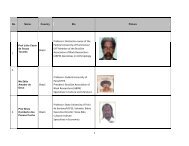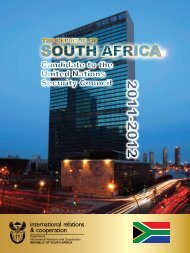Read more - Department of International Relations and Cooperation
Read more - Department of International Relations and Cooperation
Read more - Department of International Relations and Cooperation
Create successful ePaper yourself
Turn your PDF publications into a flip-book with our unique Google optimized e-Paper software.
Table <strong>of</strong> Contents<br />
I. Introduction<br />
A Population, Ethnic <strong>and</strong> demographic characteristic 4<br />
B Economy <strong>and</strong> poverty alleviation 4<br />
C South African Government <strong>and</strong> Legal system 4<br />
D South African Law Enforcement Agencies 4<br />
E South Africa’s response to crime: Organised Crime 4<br />
II.<br />
III.<br />
IV.<br />
<strong>International</strong> Instruments<br />
A Organised Crime Instruments signed, ratified or acceded to by South Africa 7<br />
B Terrorism Instruments signed, ratified or acceded to by South Africa 7<br />
Children, Youth <strong>and</strong> Crime<br />
A Introduction 10<br />
B Developments 10<br />
C Oversight <strong>and</strong> monitoring bodies 11<br />
D Treatment <strong>of</strong> children <strong>and</strong> youth <strong>of</strong>fenders 11<br />
E Policy development process 11<br />
F Sexual <strong>of</strong>fences amongst children <strong>and</strong> youth 11<br />
G Inter-sectoral collaboration 11<br />
Provision <strong>of</strong> technical assistance to facilitate ratification <strong>and</strong> implementation <strong>of</strong><br />
international instruments on the prevention <strong>and</strong> suppression <strong>of</strong> terrorism<br />
A Introduction 12<br />
B<br />
Protection <strong>of</strong> Constitutional Democracy against Terrorist <strong>and</strong> Related Activities (Act No. 33 <strong>of</strong><br />
2004) <strong>and</strong> other legislation to address terrorism<br />
C Complementary legislation 13<br />
D Assessments <strong>of</strong> South Africa’s capacity to deal with terrorism 13<br />
12<br />
V. Making the United Nations guidelines on crime prevention work<br />
A Introduction 14<br />
B Emerging trends in crime prevention 14<br />
C<br />
D<br />
Measures to integrate crime prevention strategies into economic, political <strong>and</strong> social<br />
development<br />
Measures to strengthen the role <strong>of</strong> crime prevention within the rule <strong>of</strong> law at local, national,<br />
regional <strong>and</strong> international levels<br />
E Progress made by member states in applying the guidelines for crime prevention 15<br />
F<br />
G<br />
H<br />
I<br />
Good practices in the development <strong>and</strong> implementation <strong>of</strong> crime prevention programmes at<br />
local, national, regional <strong>and</strong> international level<br />
Main obstacles in the development <strong>and</strong> implementation <strong>of</strong> programmes for crime prevention at<br />
central <strong>and</strong> local level<br />
Training <strong>of</strong> criminal justice pr<strong>of</strong>essionals <strong>and</strong> community personnel to enhance the effectiveness<br />
<strong>of</strong> crime prevention strategies<br />
Steps taken to enhance the dissemination <strong>of</strong> relevant crime prevention knowledge to local<br />
authorities <strong>and</strong> national governments<br />
14<br />
15<br />
15<br />
16<br />
16<br />
16<br />
1 Country Report

















